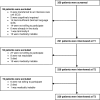Medical patients' affective well-being after emergency department admission: The role of personal and social resources and health-related variables
- PMID: 30893347
- PMCID: PMC6426177
- DOI: 10.1371/journal.pone.0212900
Medical patients' affective well-being after emergency department admission: The role of personal and social resources and health-related variables
Abstract
Background: Medical emergency admissions are critical life events associated with considerable stress. However, research on patients' affective well-being after emergency department (ED) admission is scarce. This study investigated the course of affective well-being of medical patients following an ED admission and examined the role of personal and social resources and health-related variables.
Methods: In this longitudinal survey with a sample of 229 patients with lower respiratory tract infections and cardiac diseases (taken between October 2013 and December 2014), positive and negative affect was measured at ED admission (T1) and at follow-up after 7 days (T2), and 30 days (T3). The role of personal and social resources (emotional stability, trait resilience, affect state, and social support) as well as health-related variables (self-rated health, multimorbidity, and psychological comorbidity) in patients' affective well-being was examined by controlling for demographic characteristics using regression analyses.
Results: The strength of the inverse correlation between positive and negative affect decreased over time. In addition to health-related variables, higher negative affect was predicted by higher psychological comorbidity over time (T1-T3). In turn, lower positive affect was predicted by lower self-rated health (T1-T2) and higher multimorbidity (T3). In terms of personal and social resources, lower negative affect was predicted by higher emotional stability (T2), whereas higher positive affect was predicted by stronger social support (T1-T2).
Conclusion: Knowledge about psychosocial determinants-personal and social resources and health-related variables-of patients' affective well-being following ED admission is essential for designing more effective routine screening and treatment.
Conflict of interest statement
The authors have declared that no competing interests exist.
Figures
Similar articles
-
Psychological distress in medical patients 30 days following an emergency department admission: results from a prospective, observational study.BMC Emerg Med. 2016 Aug 24;16(1):33. doi: 10.1186/s12873-016-0097-y. BMC Emerg Med. 2016. PMID: 27557531 Free PMC article.
-
The relationship of the job demands-control-support model with vigor across time: testing for reciprocality.Appl Psychol Health Well Being. 2012 Nov;4(3):276-98. doi: 10.1111/j.1758-0854.2012.01074.x. Epub 2012 Jun 20. Appl Psychol Health Well Being. 2012. PMID: 23081764
-
Connections between academic burnout, resilience, and psychological well-being in nursing students: A longitudinal study.J Adv Nurs. 2018 Dec;74(12):2777-2784. doi: 10.1111/jan.13794. Epub 2018 Aug 29. J Adv Nurs. 2018. PMID: 29992596
-
Out-of-hospital cardiac arrests in Switzerland: Predictors for emergency department mortality in patients with ROSC or on-going CPR on admission to the emergency department.PLoS One. 2017 Nov 16;12(11):e0188180. doi: 10.1371/journal.pone.0188180. eCollection 2017. PLoS One. 2017. PMID: 29145510 Free PMC article.
-
Stress and well-being at work: a literature review.Cien Saude Colet. 2020 Jul 8;25(7):2721-2736. doi: 10.1590/1413-81232020257.27902017. Cien Saude Colet. 2020. PMID: 32667554 English, Portuguese.
Cited by
-
Self-reported health and life satisfaction in older emergency department patients: sociodemographic, disease-related and care-specific associated factors.BMC Public Health. 2021 Jul 21;21(1):1440. doi: 10.1186/s12889-021-11439-8. BMC Public Health. 2021. PMID: 34289829 Free PMC article.
-
Emergency department consultations for respiratory symptoms revisited: exploratory investigation of longitudinal trends in patients' perspective on care, health care utilization, and general and mental health, from a multicenter study in Berlin, Germany.BMC Health Serv Res. 2022 Feb 10;22(1):169. doi: 10.1186/s12913-022-07591-5. BMC Health Serv Res. 2022. PMID: 35139850 Free PMC article.
-
Emergency Department Comprehensive Social Risk Screening and Resource Referral Program.West J Emerg Med. 2025 Feb 25;26(3):387-395. doi: 10.5811/westjem.18578. West J Emerg Med. 2025. PMID: 40561970 Free PMC article.
-
A cross-sectional study to assess job strain of emergency healthcare workers by Karasek questionnaire: The SEEK study.Front Psychiatry. 2023 Jan 5;13:1043110. doi: 10.3389/fpsyt.2022.1043110. eCollection 2022. Front Psychiatry. 2023. PMID: 36684020 Free PMC article.
-
Quality of acute internal medicine: A patient-centered approach. Validation and usage of the Patient Reported Measure-acute care in the Netherlands.PLoS One. 2020 Dec 1;15(12):e0242603. doi: 10.1371/journal.pone.0242603. eCollection 2020. PLoS One. 2020. PMID: 33259508 Free PMC article.



